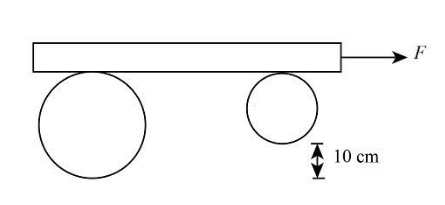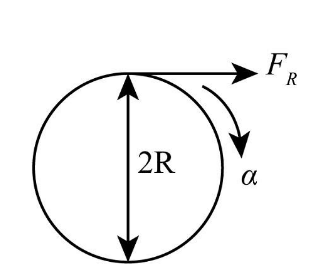Question
Question: A plank of mass \(102.5\;{\rm{kg}}\) is placed over two cylindrical radii \(R = 10\;{\rm{cm}}\) and ...
A plank of mass 102.5kg is placed over two cylindrical radii R=10cm and r=5cm. Mass of rollers is 20kg, respectively. Plank is pulled towards right by applying a horizontal force F=35N as shown in fig. During the first second of motion the plank gets displaced by 10cm. If the plank remains horizontal and slipping does not take place, calculate the magnitude and direction of force of friction acting between Plank and bigger roller.

(A) 3N towards left
(B) 1N towards left
(C) 3N towards right
(D) 1N towards right
Solution
We can determine the frictional force between bigger roller and plank with the help of torque expression. First, draw the free body diagram of the bigger cylinder and determine the linear and angular acceleration of the roller and then use the torque expression for the determination of frictional force.
Complete step by step answer:
We know that the motion of the plank is in a forward direction. The frictional force on the plank acts opposite to the applied force, and the frictional force on the bigger roller acts in the opposite direction of the plank's frictional force. We will use this formation and draw the free body diagram of the bigger roller.

Write the equation of motion so that we can calculate the linear acceleration of the roller.
s=ut+21at2
Here t is the time, u is the roller's initial speed, a is the linear acceleration and s is displacement.
Substitute the given values in the above equation.
Therefore, we get
Now we will use the relation of linear and angular acceleration so that we will determine the tangential acceleration. Therefore, we get
⇒a=αD ⇒a=α(2R)
Here, α is the angular acceleration and D is the diameter of the bigger roller, put ⇒a=0.2m/ms2s2 and R=10cm in the above equation.
⇒0.2m/ms2s2=α(2×10cm×100cm1m) ⇒α=0.2m0.2m/ms2s2 ⇒α=1rad/s
Write the expression of the torque acting on the roller.
⇒T=FR×2R …… (1)
Here, FR is the frictional force.
But we know that another expression of torque is,
⇒T=Iα …… (2)
Here, I is the rotational moment of inertia.
We know that the expression of the rotational moment of the inertia is,
⇒I=Icenter+Iside ⇒I=2MR2+MR2 …… (3)
Here , M is the mass of the bigger roller, Icenter is the moment of inertia at the centre of the roller and Iside is the momentum of inertia at the roller's circumference.
We will use equation (1), (2), and (3) for the calculation of the frictional force between the bigger roller and the plank.
Therefore, we get
⇒FR×2R=Iα ⇒FR×2R=(2MR2+MR2)α ⇒FR×2R=23MR2a ⇒FR=43MRa
Substitute the values in the above equation.
Therefore, the frictional force magnitude is 3N, and its direction is towards the right because the magnitude of the friction is positive.
Note: Remember the relation between linear and angular acceleration as well as expressions of the torque. Also, perform the required unit conversion during the calculation like centimeter into the meter to obtain the correct answer present in the given options.
